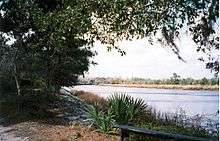Ashley River (South Carolina)


The Ashley River is a blackwater / tidal river in South Carolina, rising from the Wassamassaw and Great Cypress Swamps in western Berkeley County. It consolidates its main channel about five miles west of Summerville, widening into a tidal estuary just south of Fort Dorchester. The river then flows for approximately 17 miles along the historical banks of the City of North Charleston before reaching peninsular Charleston. The much wider Ashley joins the Cooper River off the Battery in Charleston to form Charleston Harbor before discharging into the Atlantic Ocean. At the present time the land around the Ashley River or in Ashley Barony, as the original land grant was called, is mostly undeveloped.[1]
The river was named for Anthony Ashley Cooper, 1st Earl of Shaftesbury and chief Lord Proprietor of the Carolina Colony by explorer Robert Sandford.[2] In 1675 Cooper was granted 12,000 acres of land along the river after a permanent settlement was made at Albemarle Point in 1670. This settlement was the “first permanent European settlement” in South Carolina and today Albemarle Point is known as Charles Towne Landing. The settlement would be moved to its current peninsular location across the river ten years later and is well known as Charleston.
The land closest to the river was developed by plantation owners throughout the eighteenth century. During the Revolutionary War the British occupied the plantations from 1780 to 1782. The major crops grown along the Ashley River included rice, indigo, and cotton. After the Civil War much of the region began to be used predominately for hunting and tourism.[3]
The Ashley River area contains 26 separate sites listed in the National Register of Historic Places with 22 miles being designated a State Scenic River, extending from Sland's Bridge (US Highway 17-A) near Summerville to the Mark Clark expressway (I-526) bridge in Charleston. Within this segment, a visitor can experience a blackwater swamp, the tides of the Atlantic, and the history of South Carolina. Some of the sites include Drayton Hall, Middleton Place, Magnolia Plantation, and the Colonial Dorchester State Historic Site.
References
- ↑ "South Carolina Department of Natural Resources - Ashley Scenic River". Retrieved May 8, 2012.
- ↑ Robert Sandford, “A Relation of a Voyage on the Coast of the Province of Carolina, 1666,” in Salley, AS, ed [1911], 1967, “Narratives of Early Carolina, 1650-1708, Vol. 4 of “Original Narratives of Early American History,” Edited by J. Franklin Jameson (New York: Barnes and Noble) p. 108, found in Lockhart, Matthew A. “Quitting More Than Port Royal: A Political Interpretation of the Siting and Development of Charles Town, South Carolina, 1660-1680”, Southeastern Geographer, Vol 43, N 2, Nov 2003, UNC Press
- ↑ "The History of the Ashley River Corridor". Retrieved Oct 10, 2014.
External links
U.S. Geological Survey Geographic Names Information System: Ashley River
Coordinates: 32°45′46″N 79°55′44″W / 32.76278°N 79.92889°W